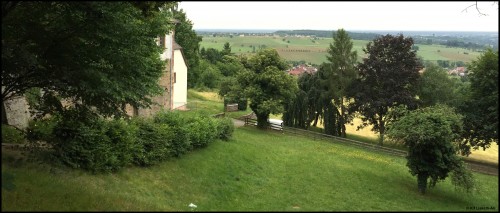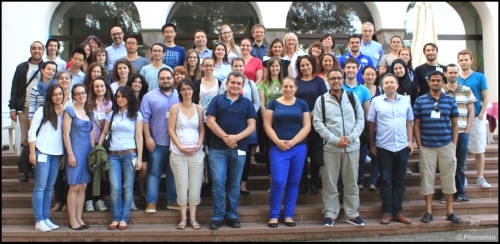European Advanced School for Mouse Phenogenomics – pushing the boundaries of mouse genetics
Posted by Kif Liakath-Ali, on 24 July 2015
The laboratory mouse has been a popular model in mammalian biology for obvious reasons and it has contributed to a number of landmark discoveries in biomedical research. Despite this, few courses and summer schools – which train future leaders in this field – focus on mouse genetics. Phenomin, a large-scale French national infrastructure for biology and health has organised the first European Advanced School for Mouse Phenogenomics. I was fortunate to be selected to participate in this school, which was held last month at a French château set atop a picturesque Alsacian landscape, some 30 miles from Strasbourg.
The theme of the school was “good practices regarding the use of mouse models for biomedical research”. The four-day programme encompassed topics on mouse genetics, mutagenesis, functional tests using mouse models and international initiatives, databases and resources. Around 30 experts from these areas engaged the participants with their various talks and discussions.
Participants were mostly PhD students and some postdocs. The school began with a talk by Dr Yann Hérault of the Mouse Clinical Institute (ICS), Strasbourg. He introduced the structure and goals of Phenomin. Following this, Professor Emeritus Jean-Louis Guénet of Institut Pasteur gave an excellent lecture on the different populations of laboratory animals. He took us through the classical aspects of mouse genetics that reminded us of our university genetics lessons and refreshed our knowledge of this topic. This talk served as a prelude to the other sessions.
Many talks focused on recent advances in mutagenesis methods, especially the CRISPR/Cas9 technology. Although this method has been developed only recently, many labs around the world have picked it up quickly. One of the key advantages of this method is that it allows researchers to produce mouse mutants in a very short space of time, with fewer or no off-target effects when compared to other nuclease mediated mutagenesis methods. During the school, we discussed the limitations of this method, especially the ability to produce conditional/inducible mutants. As we speak, a paper published last week by the Zhang lab (MIT) shows inducible human stem cell lines (with the Flp/FRT and Cre/LoxP system) engineered by CRISPR/Cas9 method by dual guide RNA targeting. This method is becoming user-friendly, favourable and a key addition to the existing mouse genetics tool box. During my short early academic career, I have witnessed at least four different mutagenesis methods; some of them disappeared and some have become famous. Without doubt, mouse genetics will see more new technologies appearing in the future that will hugely influence our current understanding of many aspects of mouse biology. It is very exciting to be a researcher in this era of cutting-edge molecular technologies.
There was also a focus on the large-scale resources and data that are available for the mouse genetics community, especially on those generated for knockout mice via international efforts. My PhD work itself was carried out within a close collaboration with such a consortium. Although these resources have been available for many years, I often come across young researchers who weren’t aware of these valuable sources of mouse mutants. International efforts to build such resources allow researchers to save time on producing mutants and spend more time on the research question itself. The IKMC (International Knockout Consortium) is aimed at generating and distributing mouse mutants for each and every gene in the mouse genome. The IKMC has now spun out as IMPC (International Mouse Phenotyping Consortium), which phenotypes the mutants that are produced through IKMC and makes open access of the data. Gone are the days when a PhD student or a postdoc spent their entire time on generating a knockout mouse. Now they can just ‘stop-and-shop’ a desired mutant and start the experiment without spending much time on the generating the mutant itself. The open access data on primary phenotype from IMPC could be exploited to build hypotheses and test them. Also, there exists a resource database, CREATE (Coordination of resources for conditional expression of mutated mouse alleles) for Cre driver lines for those who are interested in conditionally ablating the genes in their desired cell types – the cherry on top of the cake!
The other topic I found very interesting was immunophenomics. Professors Bernard Malissen and Marie Malissen gave insights into pilot scale immune phenotyping studies to elucidate immune complexity through functional genomics. Professor Bernard Malissen runs an ambitious project at CIPHE, the centre for Immunophenomics at Marseille-Luminy where they aim to phenotype all the cellular components of the immune system under steady state and when challenged with pathogens. The outcome of their research holds great promise in the field of immunology and infection biology.
Ethics and animal welfare were discussed intensely during the school. The participants were reminded how to consider ethics and welfare of the animal throughout their research. Dr Jan-Bas Prins of LUMC, Netherlands gave an eye-opening lecture on ethics and humane animal research. He stressed how researchers should keep in mind the principles of 3-Rs (replacement, reduction, and refinement) throughout their animal experiments.
The highlight of the school’s programme was the workgroup sessions, where the participant groups were given topics (outside their own research) and relevant articles to discuss. They were also assigned to a supervisor/expert with whom they could discuss the topic and finally present it for a general discussion. This allowed the participants to critically go through the assigned topic and brainstorm the questions addressed and mouse techniques used in the studies. In my case at least, I gained ‘enlightenment’ on T-cell receptors – the topic which was assigned to my group and something which was totally new to me! The school also saw two poster sessions with PhD students and postdocs showcasing their excellent works involving various mouse mutants and their relevance to various diseases.
Kudos to the organisers of the school! They did a fantastic job of putting together a programme which perfectly fitted the needs of mouse genetics researchers and those who have begun their PhD studies. I hope the organisers will be able to secure funding to conduct the school in coming years. Although the sun decided not to shine during most of the days of the school, we were intensely soaked with science throughout the week!
This post is also available from our lab blog – wattlab blog. Please visit for more interesting topics and discussions.




 (2 votes)
(2 votes)